
Deutsche Bank Global Automotive Conference Ford Motor Company | January 16, 2018
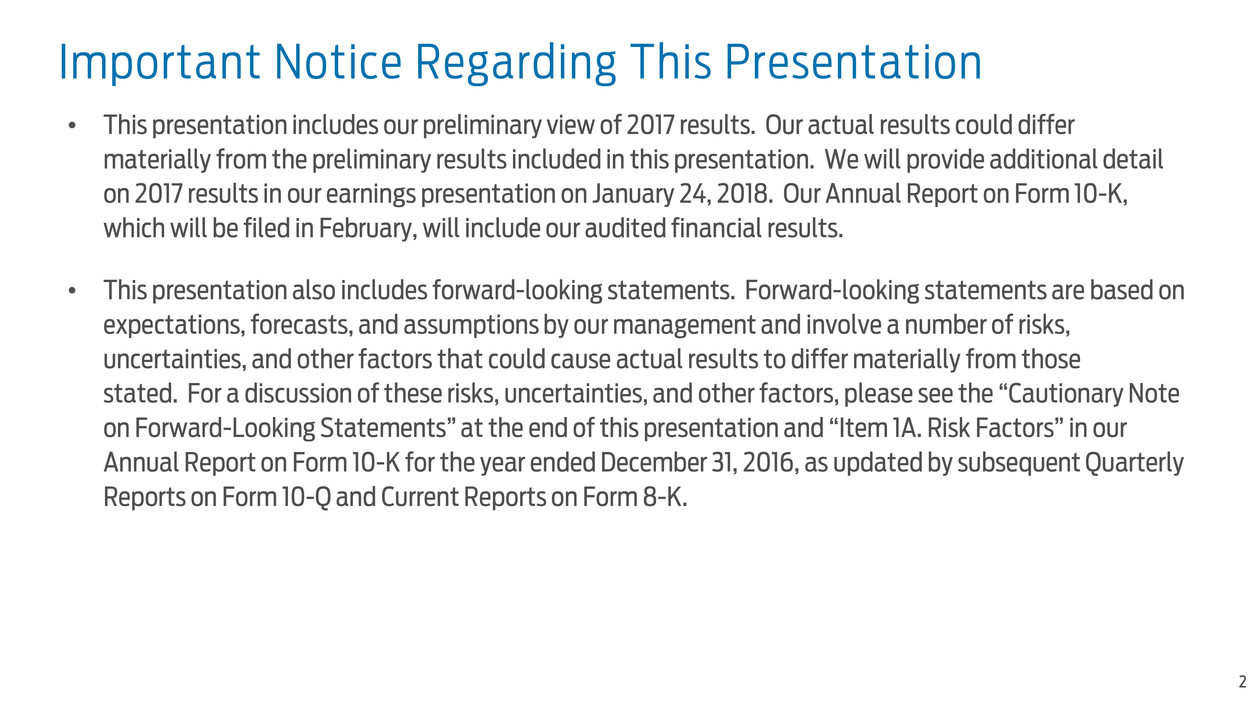
2 • This presentation includes our preliminary view of 2017 results. Our actual results could differ materially from the preliminary results included in this presentation. We will provide additional detail on 2017 results in our earnings presentation on January 24, 2018. Our Annual Report on Form 10-K, which will be filed in February, will include our audited financial results. • This presentation also includes forward-looking statements. Forward-looking statements are based on expectations, forecasts, and assumptions by our management and involve a number of risks, uncertainties, and other factors that could cause actual results to differ materially from those stated. For a discussion of these risks, uncertainties, and other factors, please see the “Cautionary Note on Forward-Looking Statements” at the end of this presentation and “Item 1A. Risk Factors” in our Annual Report on Form 10-K for the year ended December 31, 2016, as updated by subsequent Quarterly Reports on Form 10-Q and Current Reports on Form 8-K. Important Notice Regarding This Presentation

3 Bob Shanks Chief Financial Officer
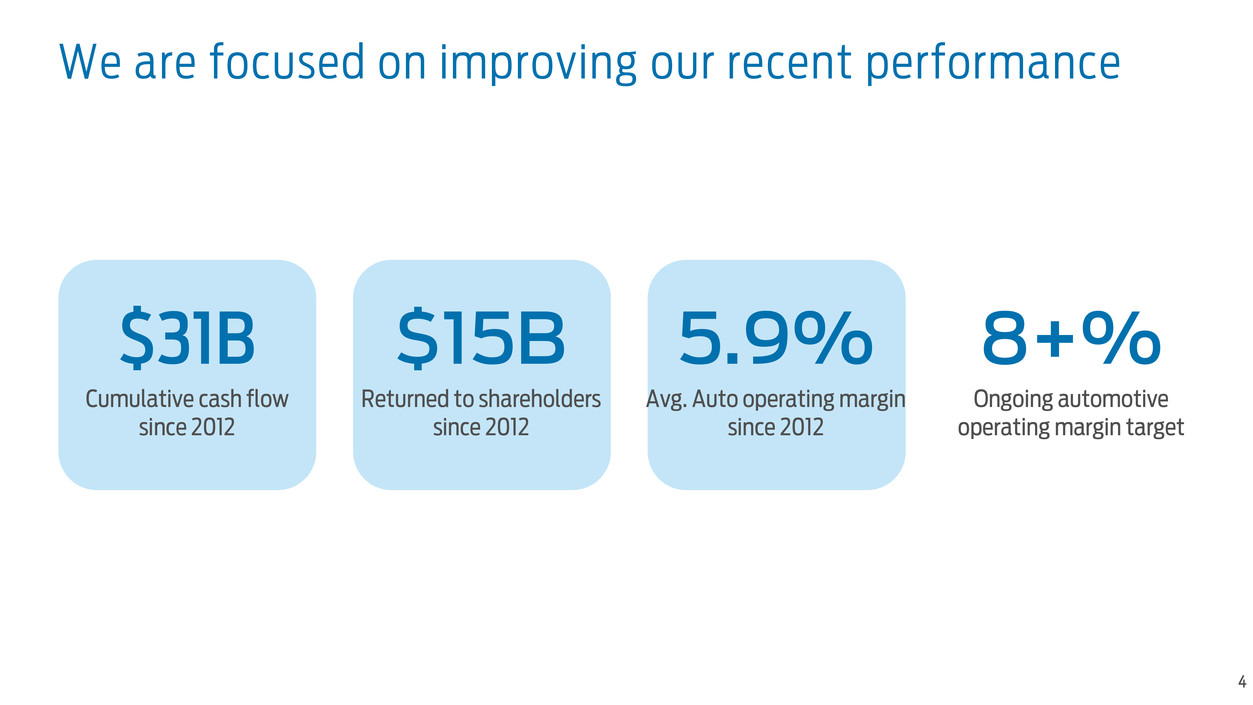
4 We are focused on improving our recent performance Cumulative cash flow since 2012 $31B Returned to shareholders since 2012 $15B Avg. Auto operating margin since 2012 5.9% Ongoing automotive operating margin target 8+%

5 And working to win in a future of Smart Vehicles in a Smart World
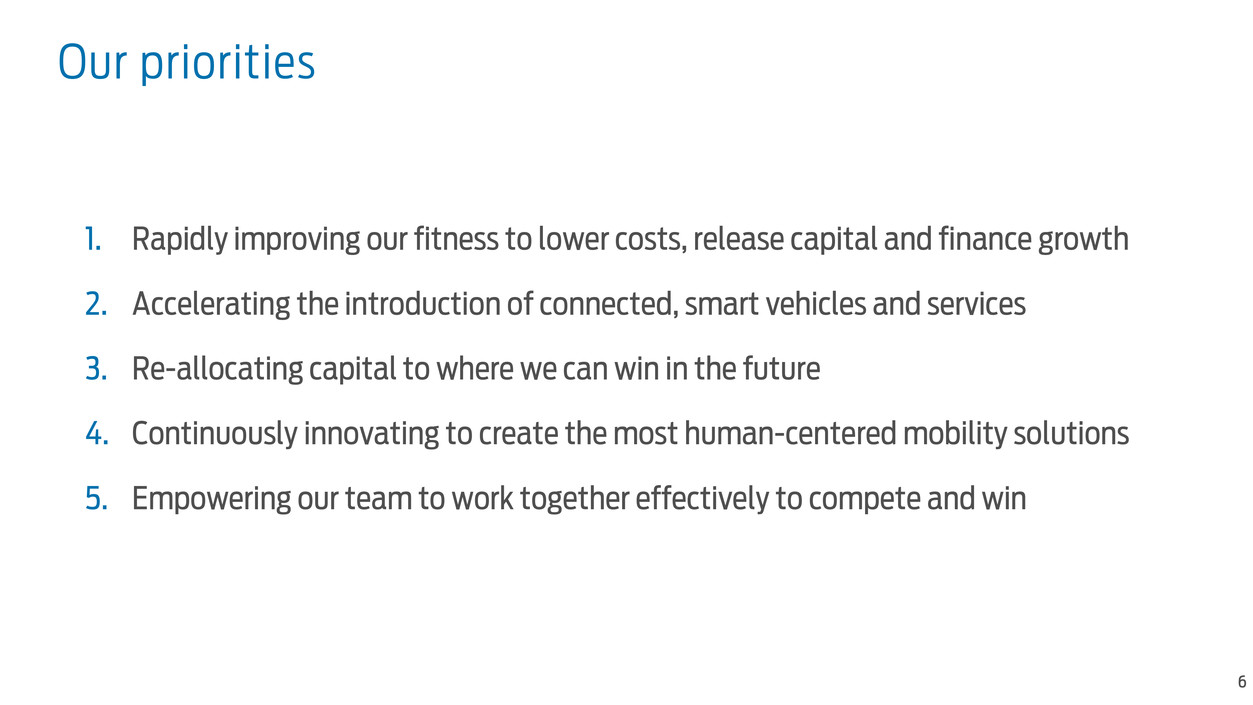
6 Our priorities 1. Rapidly improving our fitness to lower costs, release capital and finance growth 2. Accelerating the introduction of connected, smart vehicles and services 3. Re-allocating capital to where we can win in the future 4. Continuously innovating to create the most human-centered mobility solutions 5. Empowering our team to work together effectively to compete and win

7 In 2017 we delivered solid results, in line with guidance Company Revenue (GAAP) Company Adjusted Pre-Tax Results* (Non-GAAP) Adjusted EPS* (Non-GAAP) EPS (GAAP) Automotive Segment Operating Margin (GAAP) Automotive Segment Operating Cash Flow (GAAP) FY 2017 $156.8B $8.4B $1.78 $1.95 5.0% $3.9B B / (W) FY 2016 $5.0B $(1.9)B $0.02 $0.80 (1.7) ppts $(2.5)B $ * See Appendix for detail, reconciliation to GAAP and definitions
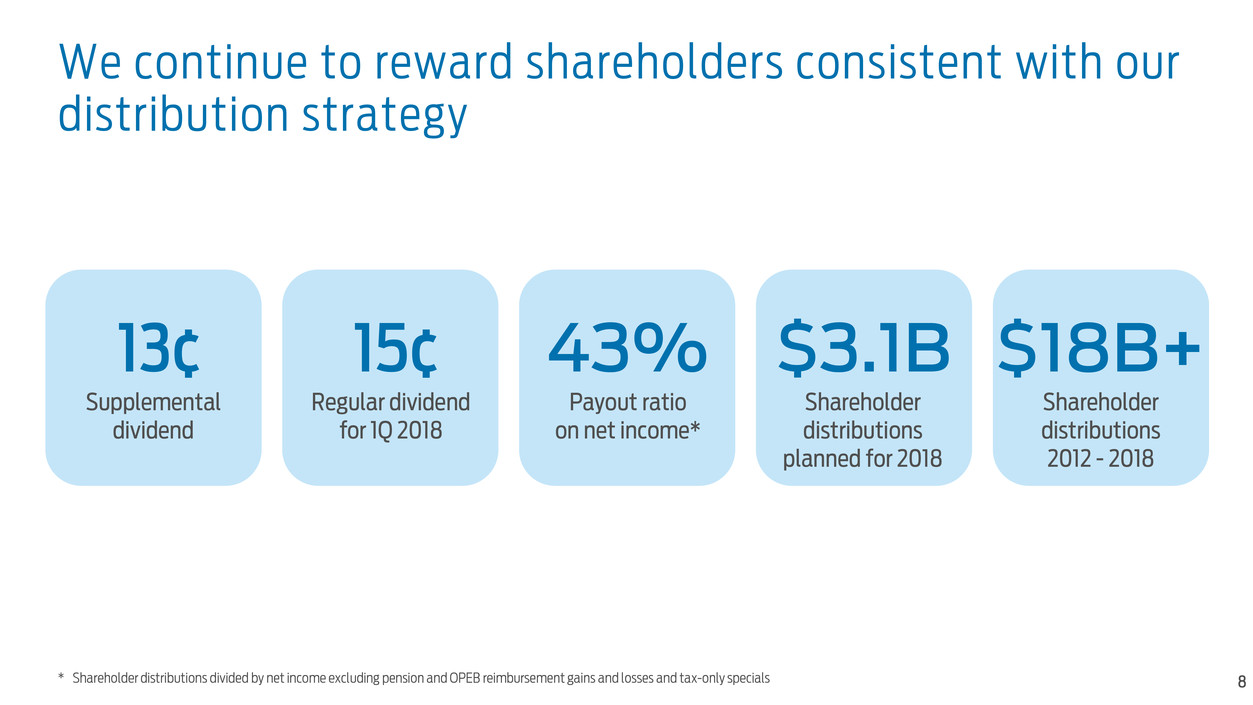
8 We continue to reward shareholders consistent with our distribution strategy Supplemental dividend 13¢ Payout ratio on net income* 43% Shareholder distributions 2012 - 2018 $18B+ * Shareholder distributions divided by net income excluding pension and OPEB reimbursement gains and losses and tax-only specials Regular dividend for 1Q 2018 15¢ Shareholder distributions planned for 2018 $3.1B
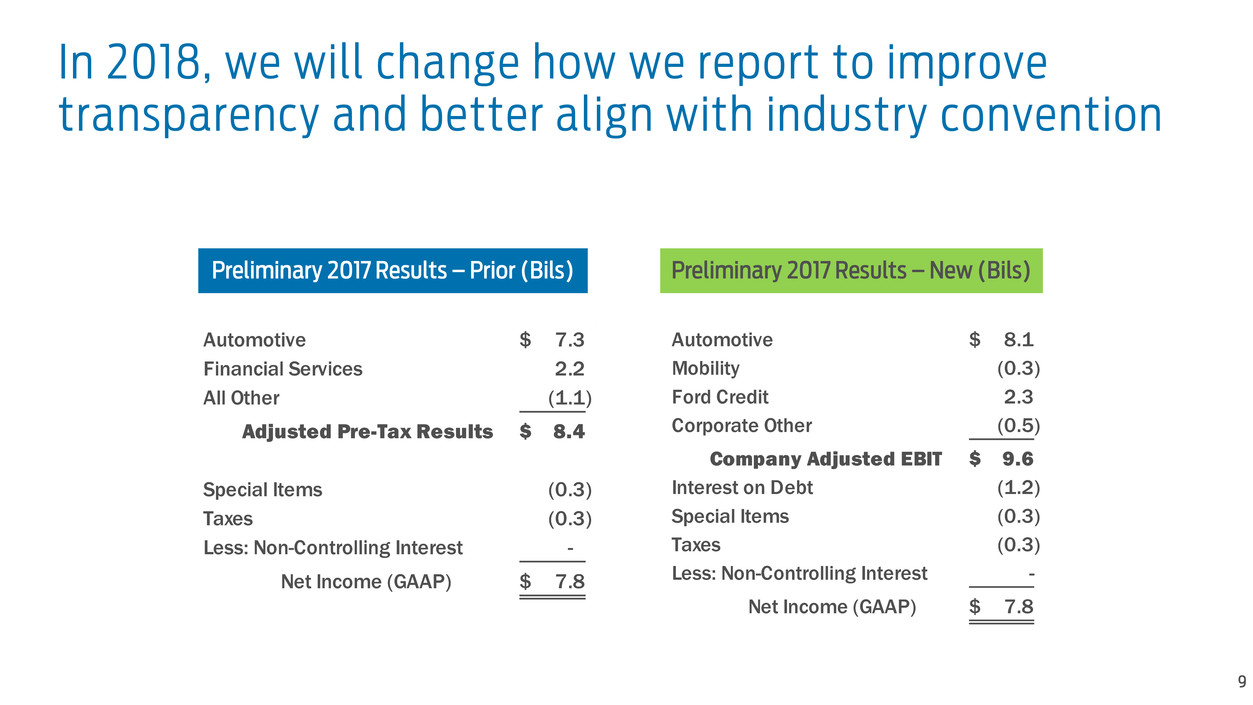
9 In 2018, we will change how we report to improve transparency and better align with industry convention Automotive 7.3$ Financial Services 2.2 All Other (1.1) Adjusted Pre-Tax Results 8.4$ Special Items (0.3) Taxes (0.3) Less: Non-Controlling Interest - Net Income (GAAP) 7.8$ Preliminary 2017 Results – Prior (Bils) Preliminary 2017 Results – New (Bils) Automotive 8.1$ Mobility (0.3) Ford Credit 2.3 Corporate Other (0.5) Company Adjusted EBIT 9.6$ Interest on Debt (1.2) Special Items (0.3) Taxes (0.3) Less: Non-Controlling Interest - Net Income (GAAP) 7.8$

10 U.S. tax reform is expected to have a beneficial impact on Ford Tax Reform Element Preliminary Results / Expected Outcome 2018 Adjusted Effective Tax Rate ~15% Ongoing Tax Rate (2019+) ~18% (down from ~30%) Impact of Tax Reform On 2017 Results Not Material Tax Credit Carryovers Retained Dollar-For-Dollar Impact of Limits on Net Interest Expense None
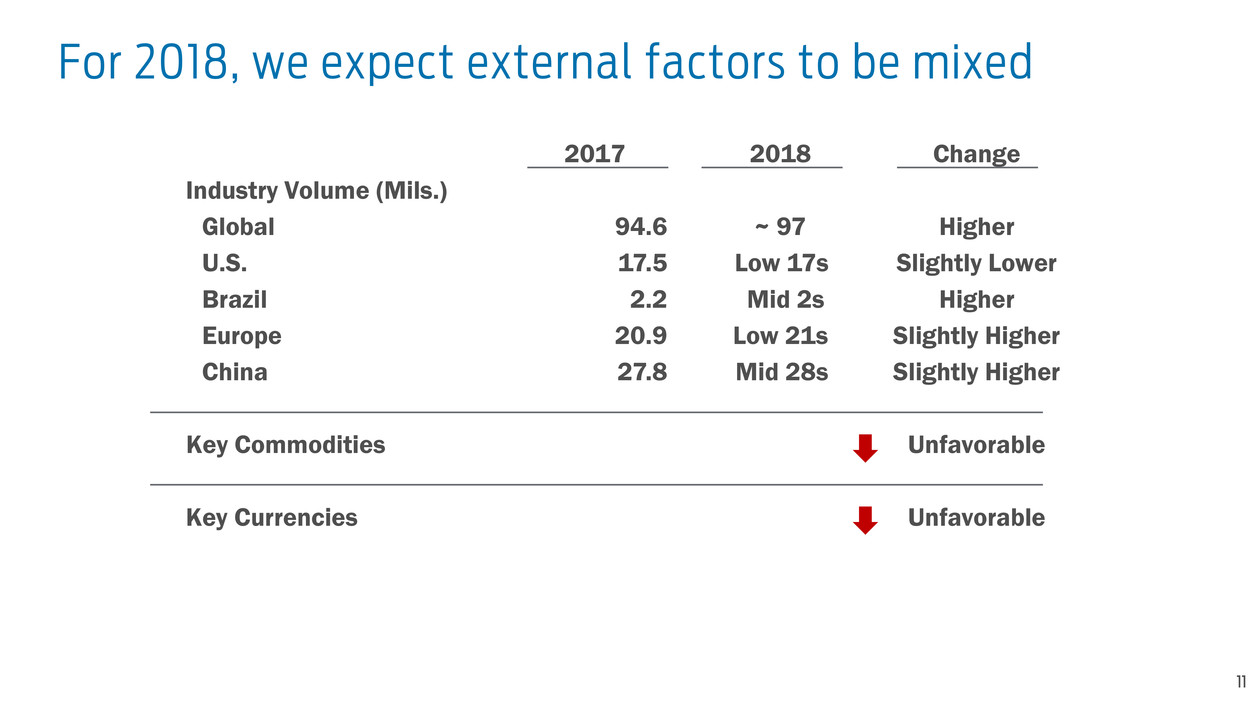
11 For 2018, we expect external factors to be mixed 2017 2018 Change Industry Volume (Mils.) Global 94.6 ~ 97 Higher U.S. 17.5 Low 17s Slightly Lower Brazil 2.2 Mid 2s Higher Europe 20.9 Low 21s Slightly Higher China 27.8 Mid 28s Slightly Higher Key Commodities Unfavorable Key Currencies Unfavorable
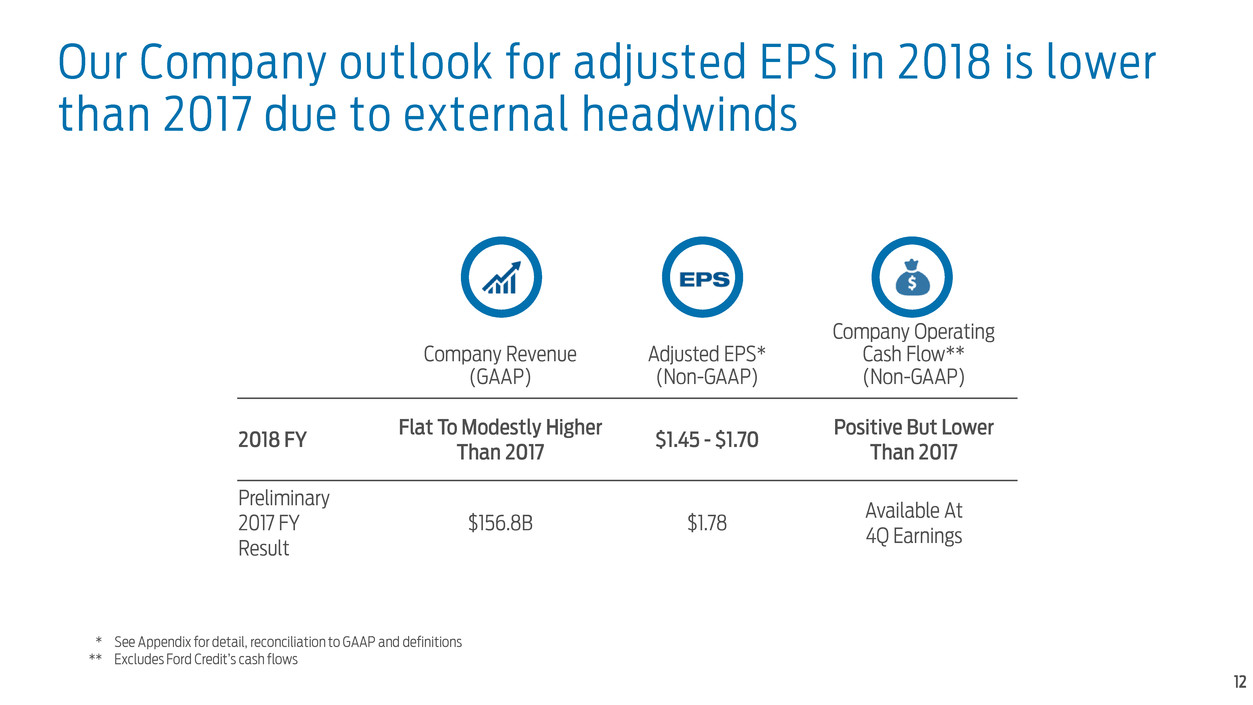
12 Our Company outlook for adjusted EPS in 2018 is lower than 2017 due to external headwinds Company Revenue (GAAP) Adjusted EPS* (Non-GAAP) Company Operating Cash Flow** (Non-GAAP) 2018 FY Flat To Modestly Higher Than 2017 $1.45 - $1.70 Positive But Lower Than 2017 Preliminary 2017 FY Result $156.8B $1.78 Available At4Q Earnings * See Appendix for detail, reconciliation to GAAP and definitions ** Excludes Ford Credit’s cash flows
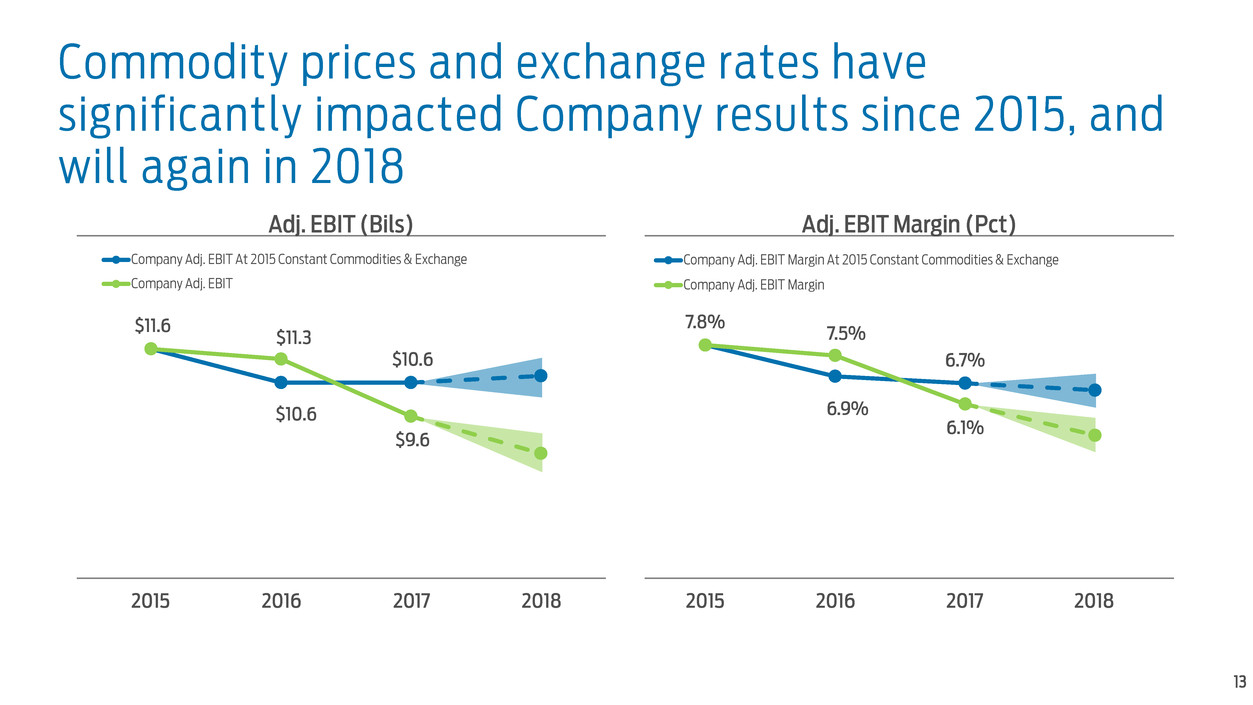
13 Commodity prices and exchange rates have significantly impacted Company results since 2015, and will again in 2018 Adj. EBIT (Bils) Adj. EBIT Margin (Pct) 2015 2016 2017 2018 2015 2016 2017 2018 $11.6 $10.6 $10.6 $11.3 $9.6 Company Adj. EBIT At 2015 Constant Commodities & Exchange Company Adj. EBIT 7.8% 6.9% 6.7% 7.5% 6.1% Company Adj. EBIT Margin At 2015 Constant Commodities & Exchange Company Adj. EBIT Margin
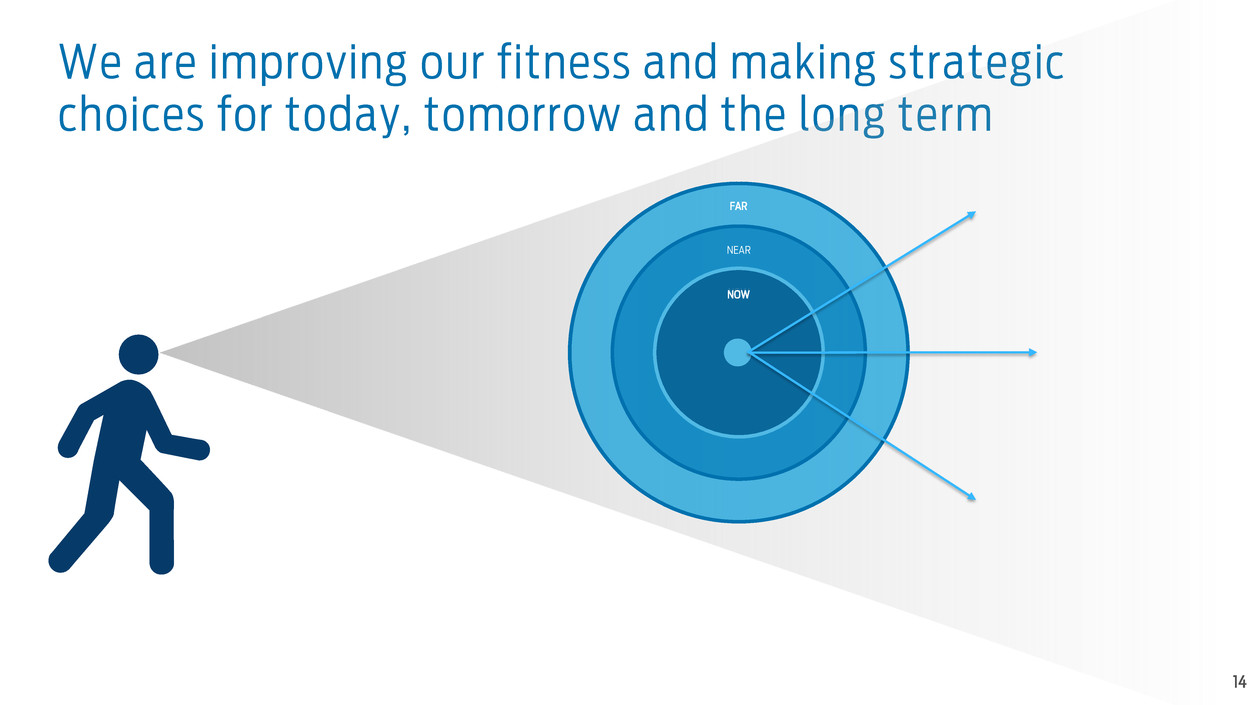
14 We are improving our fitness and making strategic choices for today, tomorrow and the long term FAR NEAR NOWNO
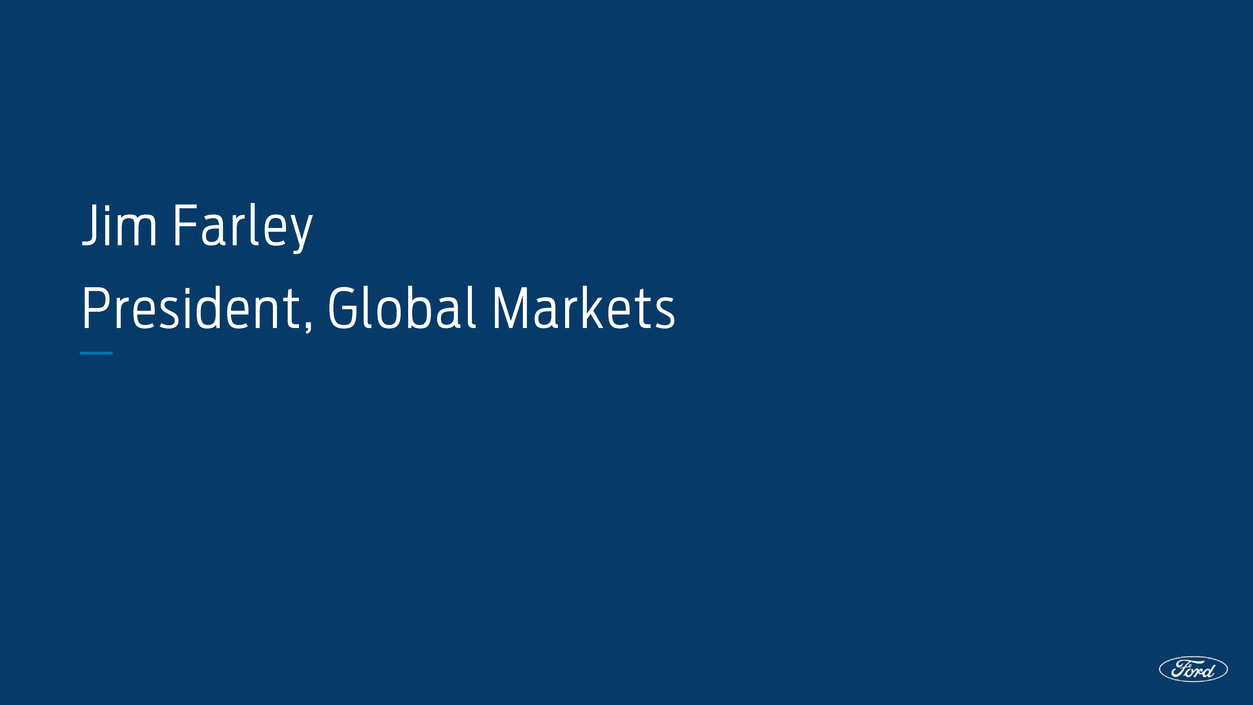
Jim Farley President, Global Markets
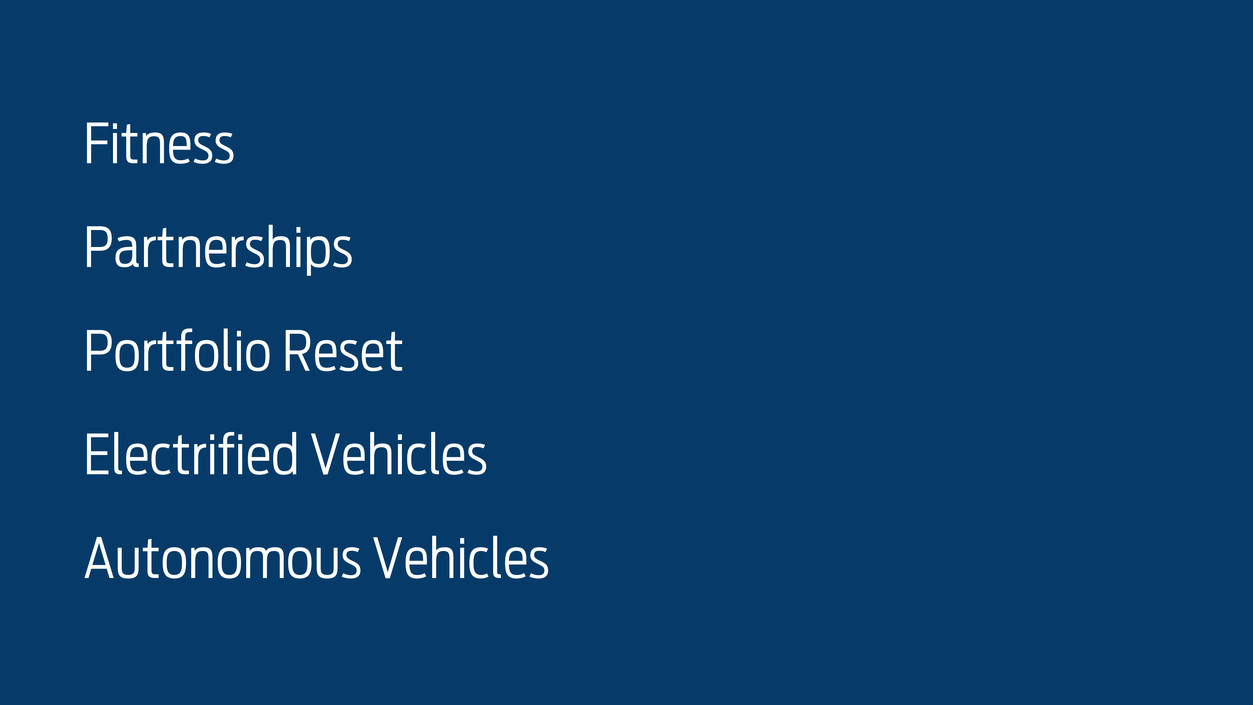
Fitness Partnerships Portfolio Reset Electrified Vehicles Autonomous Vehicles

Fitness Partnerships Portfolio Reset Electrified Vehicles Autonomous Vehicles
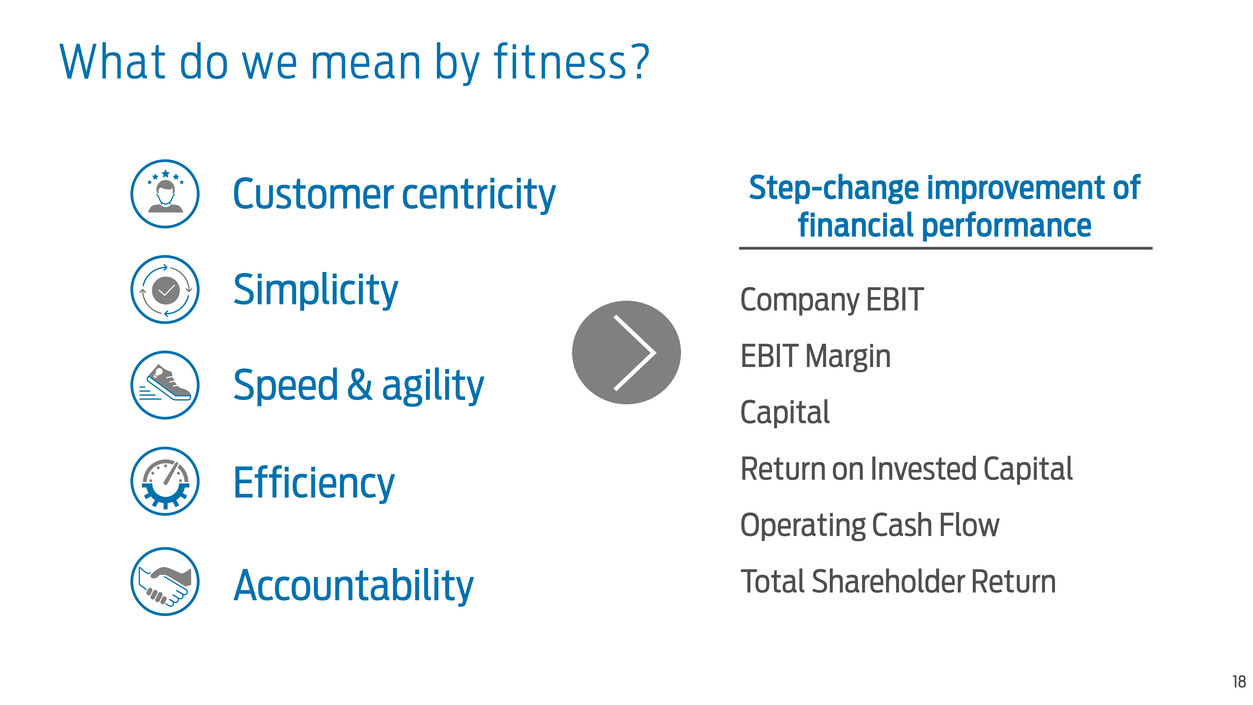
18 What do we mean by fitness? Customer centricity Simplicity Speed & agility Efficiency Accountability Step-change improvement of financial performance Company EBIT EBIT Margin Capital Return on Invested Capital Operating Cash Flow Total Shareholder Return
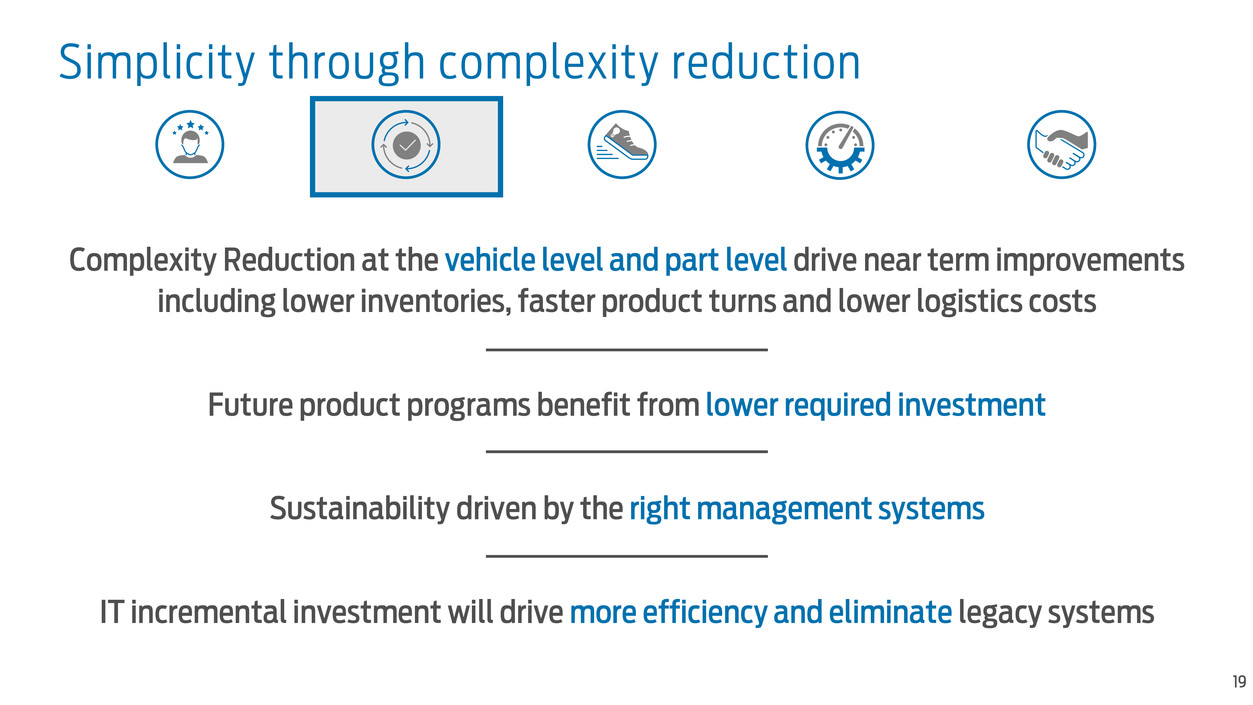
19 Simplicity through complexity reduction Complexity Reduction at the vehicle level and part level drive near term improvements including lower inventories, faster product turns and lower logistics costs Future product programs benefit from lower required investment Sustainability driven by the right management systems IT incremental investment will drive more efficiency and eliminate legacy systems
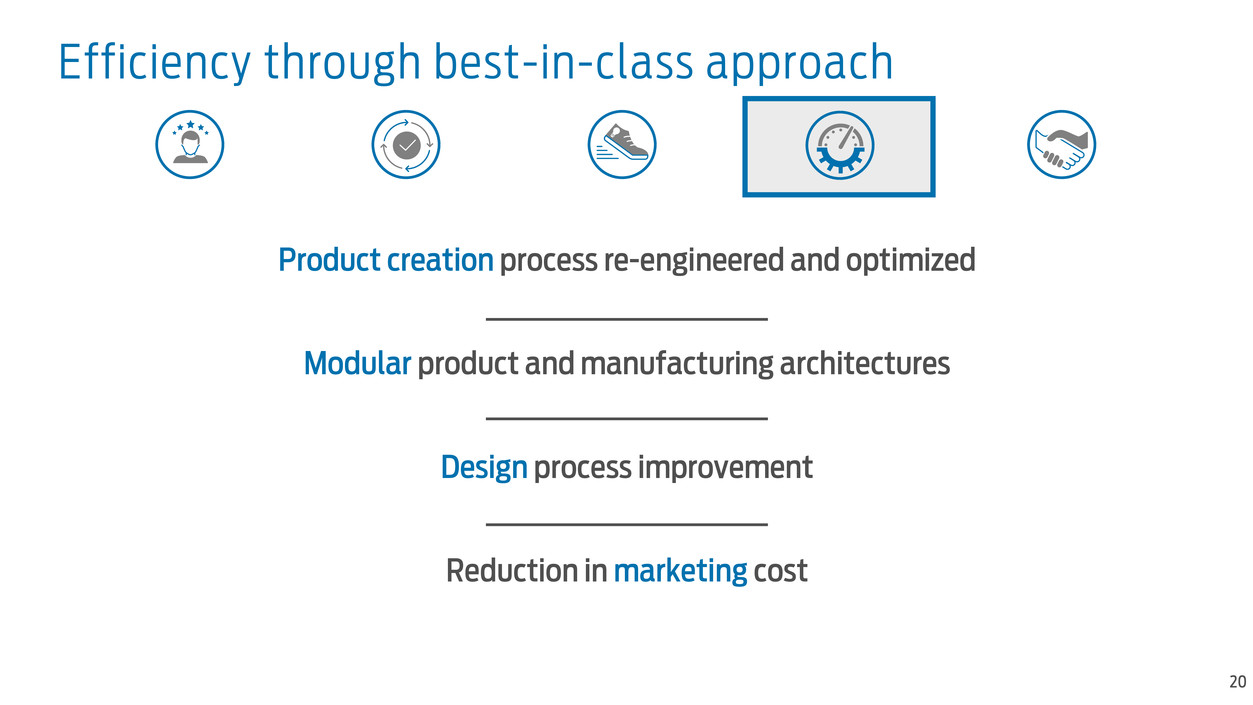
20 Efficiency through best-in-class approach Product creation process re-engineered and optimized Modular product and manufacturing architectures Design process improvement Reduction in marketing cost
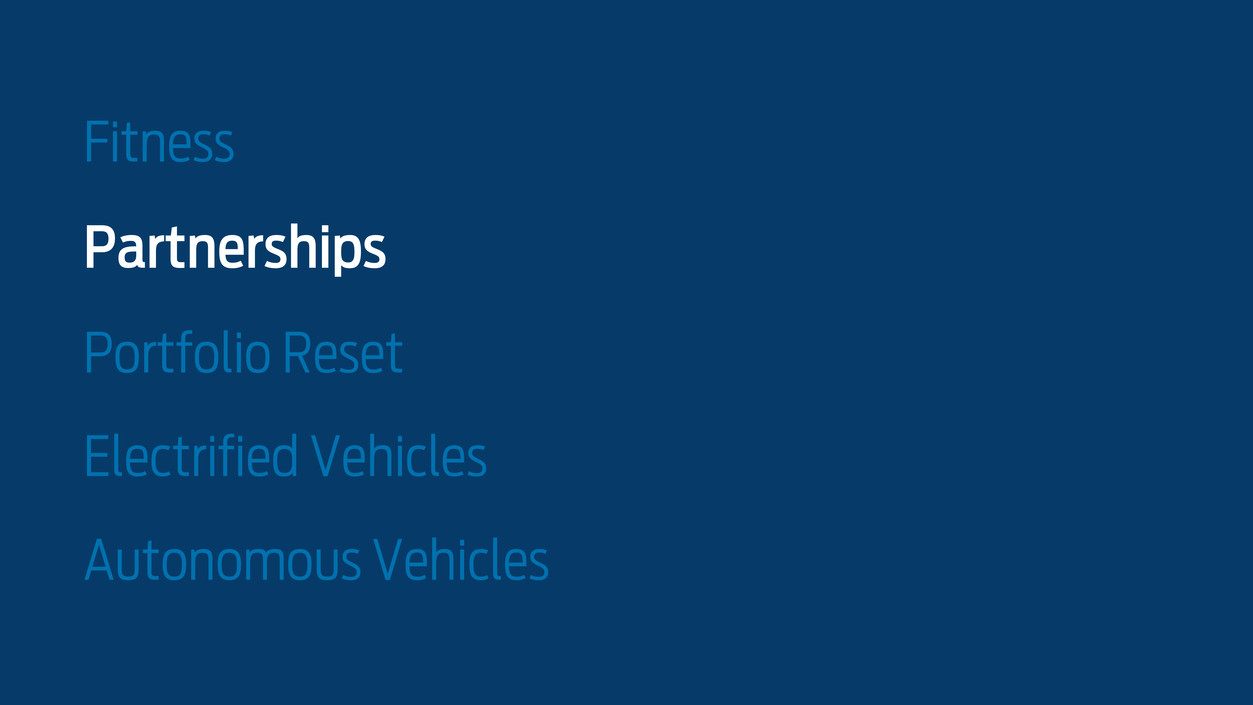
Fitness Partnerships Portfolio Reset Electrified Vehicles Autonomous Vehicles

22 Partnerships strengthen our competitive position Markets Technologies Capabilities Mobility Recently announced

Fitness Partnerships Portfolio Reset Electrified Vehicles Autonomous Vehicles
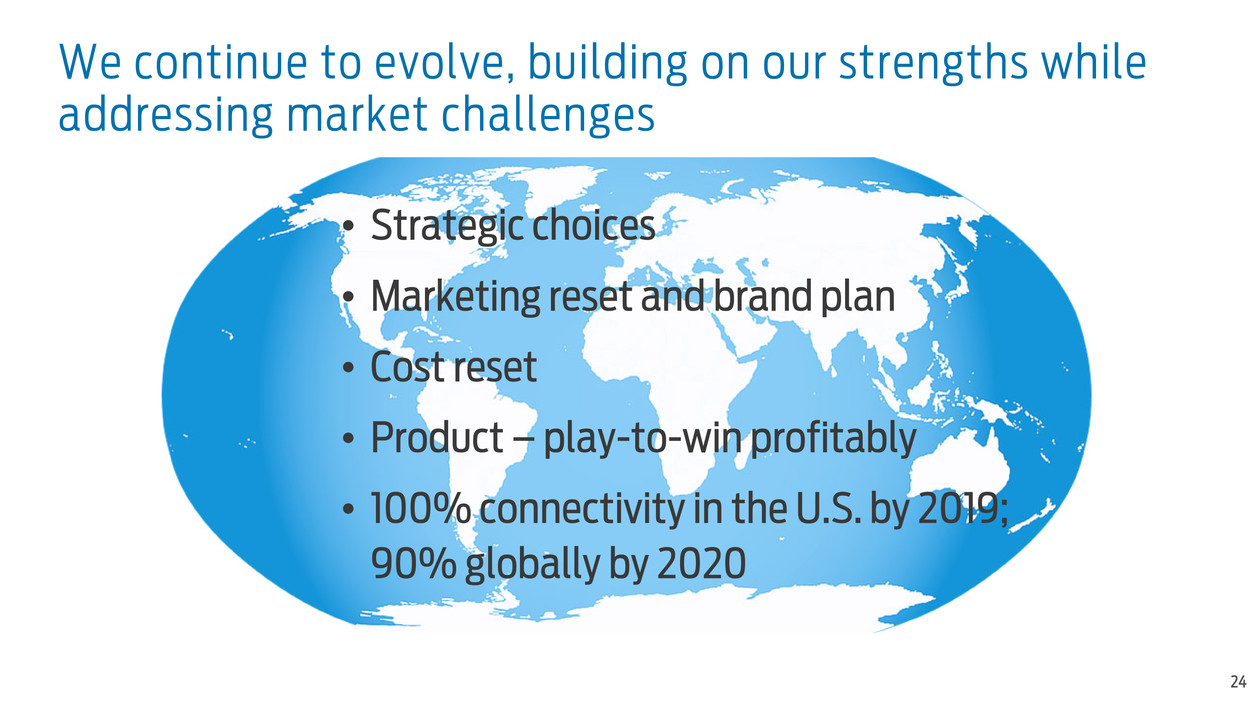
24 We continue to evolve, building on our strengths while addressing market challenges • Strategic choices • Marketing reset and brand plan • Cost reset • Product – play-to-win profitably • 100% connectivity in the U.S. by 2019; 90% globally by 2020
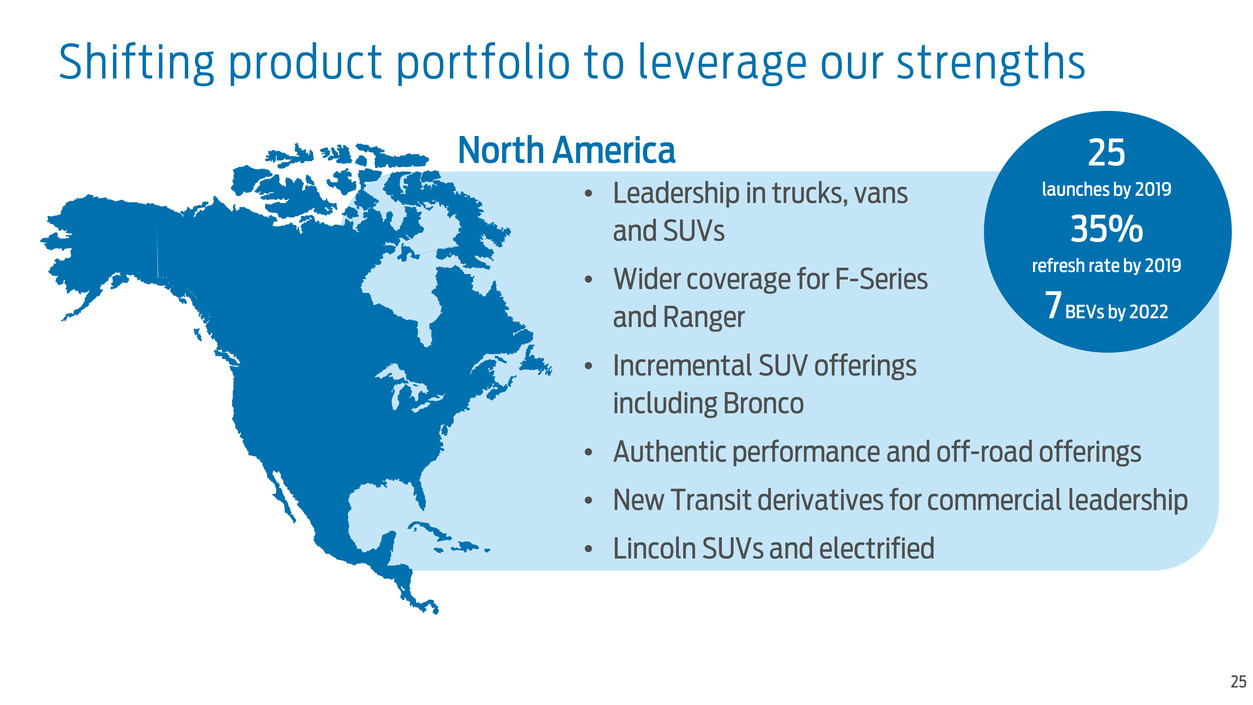
25 Shifting product portfolio to leverage our strengths • Leadership in trucks, vans and SUVs • Wider coverage for F-Series and Ranger • Incremental SUV offerings including Bronco • Authentic performance and off-road offerings • New Transit derivatives for commercial leadership • Lincoln SUVs and electrified North America 25 launches by 2019 35% refresh rate by 2019 7 BEVs by 2022

26 Shifting product portfolio to leverage our strengths • Rationalize car lineup • Small urban utilities • Authentic off-road offerings • More 3-row utilities • Expanded lineup in Russia • Continue commercial vehicle leadership • High-revenue derivatives Europe27 launches by 2019 35% refresh rate by 2019 3 BEVs by 2022

27 Shifting product portfolio to leverage our strengths Asia Pacific • Ranger growth plan in Australia, New Zealand and ASEAN • 50 new Ford and Lincoln models in China by 2025 including eight all-new SUVs and at least 15 electrified vehicles • More local assembly 24 launches by 2019 29% refresh rate by 2019 13 BEVs by 2022

Fitness Partnerships Portfolio Reset Electrified Vehicles Autonomous Vehicles

29 EV strategy plays to our strengths, builds on our brands, leverages scale and innovates across the value chain Mach I – Performance BEV F-150 Hybrid Mustang Hybrid Transit Plug-In Hybrid Ionity Fast Charging Infrastructure
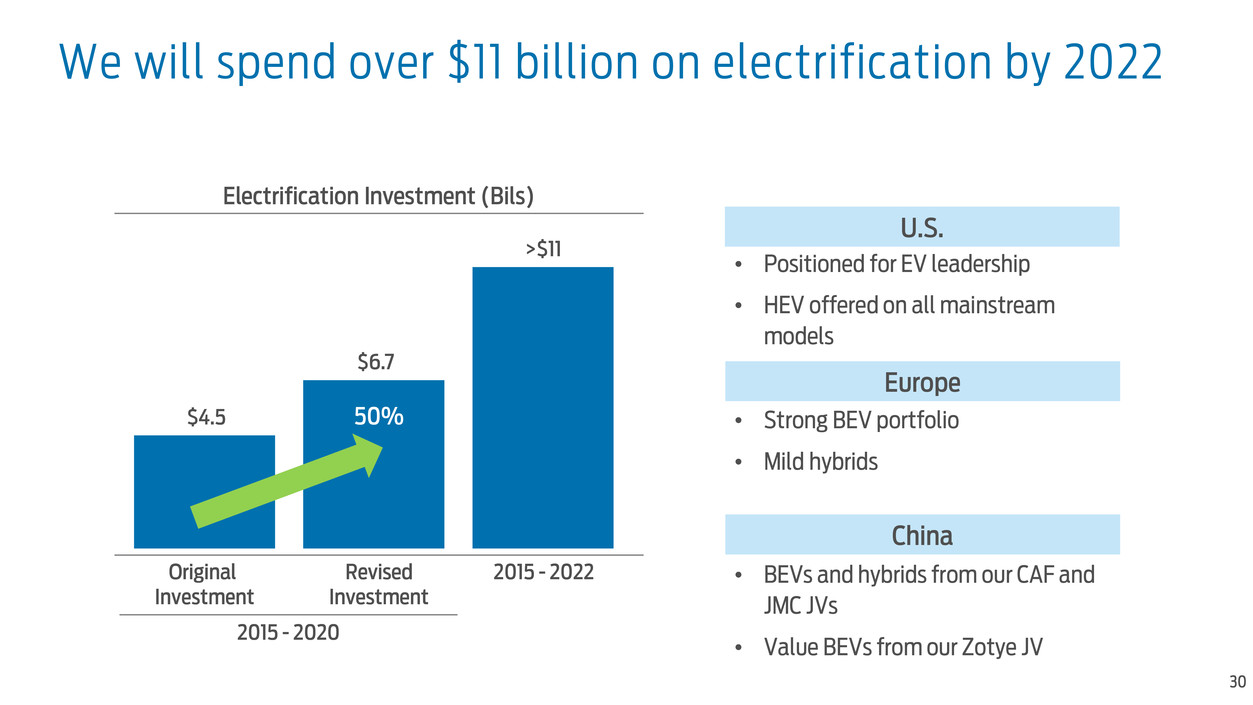
30 We will spend over $11 billion on electrification by 2022 U.S. • Positioned for EV leadership • HEV offered on all mainstream models China • BEVs and hybrids from our CAF and JMC JVs • Value BEVs from our Zotye JV Europe • Strong BEV portfolio • Mild hybrids $4.5 $6.7 >$11 Original Investment Revised Investment 2015 - 2022 Electrification Investment (Bils) 2015 - 2020 50%

31 By 2022, we will have a significant BEV and electrified lineup 16 Full Battery Electric Vehicles 40 Electrified Vehicles • Dedicated BEV platforms • Includes our trucks and vans • Supports our commercial and Lincoln businesses • Includes Zotye nameplates
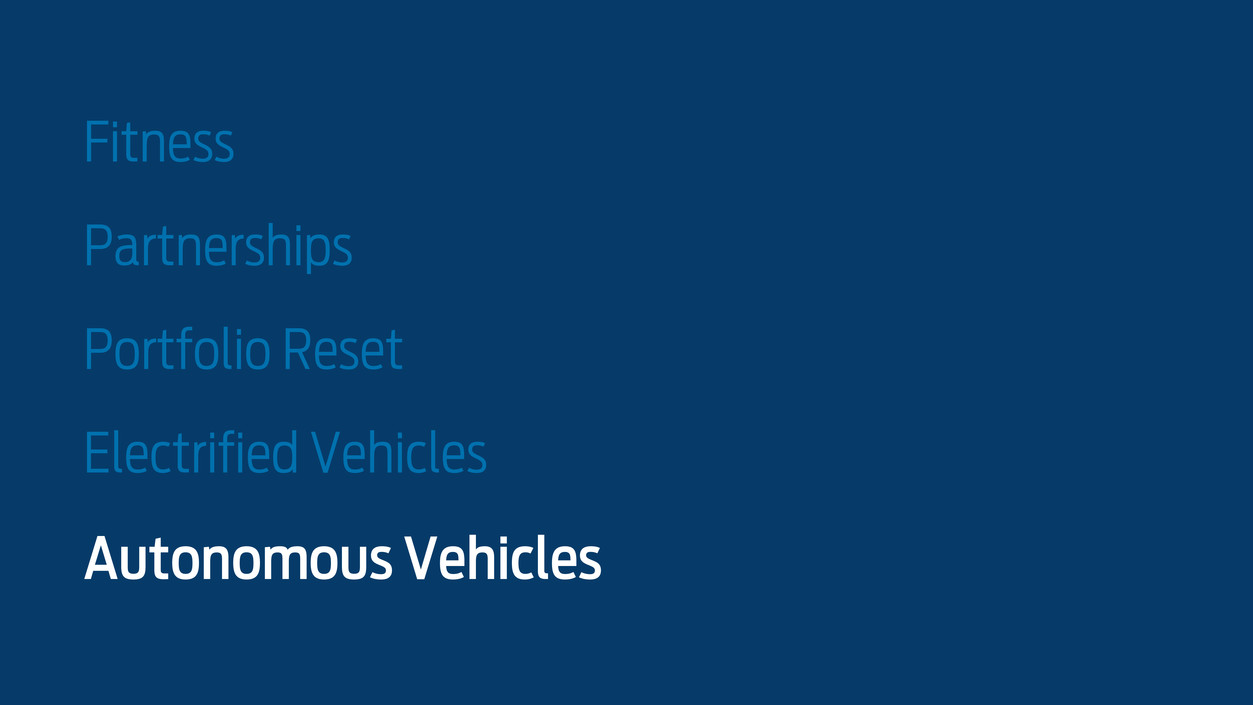
Fitness Partnerships Portfolio Reset Electrified Vehicles Autonomous Vehicles
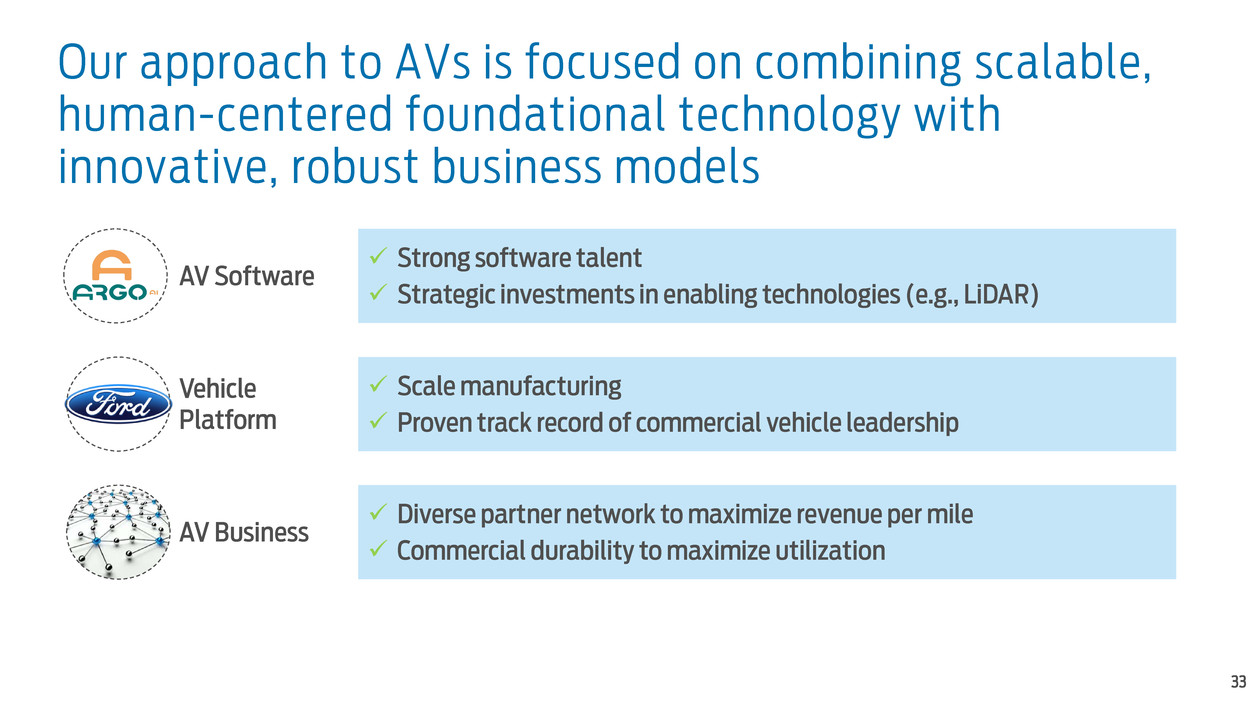
33 Our approach to AVs is focused on combining scalable, human-centered foundational technology with innovative, robust business models AV Software Strong software talent Strategic investments in enabling technologies (e.g., LiDAR) Vehicle Platform Scale manufacturing Proven track record of commercial vehicle leadership Diverse partner network to maximize revenue per mile Commercial durability to maximize utilizationAV Business

34 We are building our AV business in multiple cities in preparation for a 2021 production launch Multiple Demand Sources Maximized Revenue Per Mile & Vehicle Utilization Robust Partnership Platform Durable, Commercial Grade Technology + $ Food & Goods Delivery Ride Sharing Small Business Services
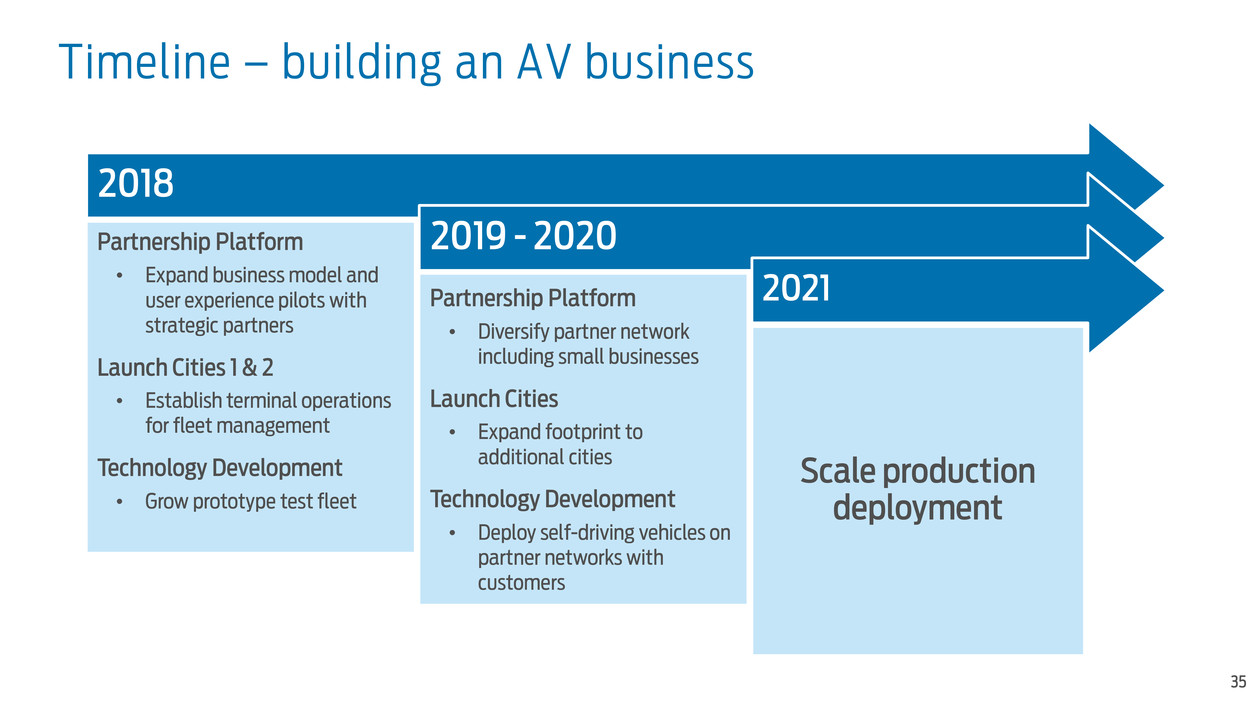
35 Timeline – building an AV business 2018 2019 - 2020 2021 Scale production deployment Partnership Platform • Expand business model and user experience pilots with strategic partners Launch Cities 1 & 2 • Establish terminal operations for fleet management Technology Development • Grow prototype test fleet Partnership Platform • Diversify partner network including small businesses Launch Cities • Expand footprint to additional cities Technology Development • Deploy self-driving vehicles on partner networks with customers
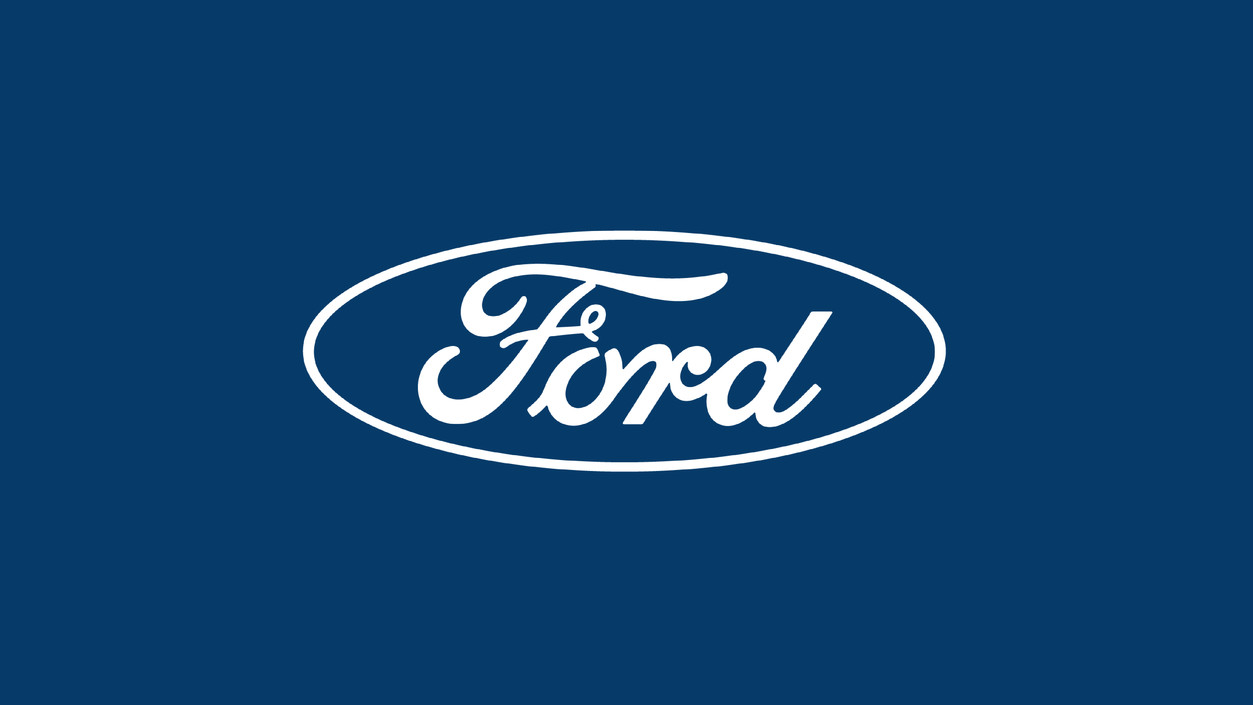
36

37 Questions & Answers
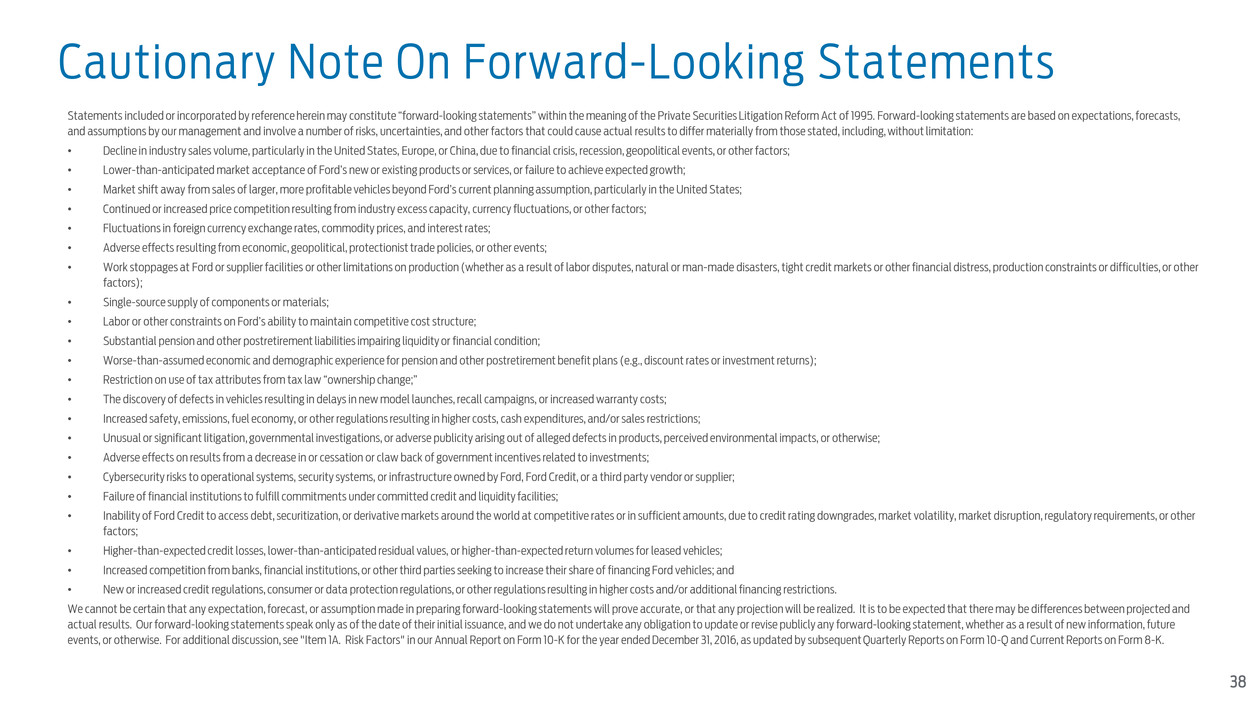
38 Statements included or incorporated by reference herein may constitute “forward-looking statements” within the meaning of the Private Securities Litigation Reform Act of 1995. Forward-looking statements are based on expectations, forecasts, and assumptions by our management and involve a number of risks, uncertainties, and other factors that could cause actual results to differ materially from those stated, including, without limitation: • Decline in industry sales volume, particularly in the United States, Europe, or China, due to financial crisis, recession, geopolitical events, or other factors; • Lower-than-anticipated market acceptance of Ford’s new or existing products or services, or failure to achieve expected growth; • Market shift away from sales of larger, more profitable vehicles beyond Ford’s current planning assumption, particularly in the United States; • Continued or increased price competition resulting from industry excess capacity, currency fluctuations, or other factors; • Fluctuations in foreign currency exchange rates, commodity prices, and interest rates; • Adverse effects resulting from economic, geopolitical, protectionist trade policies, or other events; • Work stoppages at Ford or supplier facilities or other limitations on production (whether as a result of labor disputes, natural or man-made disasters, tight credit markets or other financial distress, production constraints or difficulties, or other factors); • Single-source supply of components or materials; • Labor or other constraints on Ford’s ability to maintain competitive cost structure; • Substantial pension and other postretirement liabilities impairing liquidity or financial condition; • Worse-than-assumed economic and demographic experience for pension and other postretirement benefit plans (e.g., discount rates or investment returns); • Restriction on use of tax attributes from tax law “ownership change;” • The discovery of defects in vehicles resulting in delays in new model launches, recall campaigns, or increased warranty costs; • Increased safety, emissions, fuel economy, or other regulations resulting in higher costs, cash expenditures, and/or sales restrictions; • Unusual or significant litigation, governmental investigations, or adverse publicity arising out of alleged defects in products, perceived environmental impacts, or otherwise; • Adverse effects on results from a decrease in or cessation or claw back of government incentives related to investments; • Cybersecurity risks to operational systems, security systems, or infrastructure owned by Ford, Ford Credit, or a third party vendor or supplier; • Failure of financial institutions to fulfill commitments under committed credit and liquidity facilities; • Inability of Ford Credit to access debt, securitization, or derivative markets around the world at competitive rates or in sufficient amounts, due to credit rating downgrades, market volatility, market disruption, regulatory requirements, or other factors; • Higher-than-expected credit losses, lower-than-anticipated residual values, or higher-than-expected return volumes for leased vehicles; • Increased competition from banks, financial institutions, or other third parties seeking to increase their share of financing Ford vehicles; and • New or increased credit regulations, consumer or data protection regulations, or other regulations resulting in higher costs and/or additional financing restrictions. We cannot be certain that any expectation, forecast, or assumption made in preparing forward-looking statements will prove accurate, or that any projection will be realized. It is to be expected that there may be differences between projected and actual results. Our forward-looking statements speak only as of the date of their initial issuance, and we do not undertake any obligation to update or revise publicly any forward-looking statement, whether as a result of new information, future events, or otherwise. For additional discussion, see "Item 1A. Risk Factors" in our Annual Report on Form 10-K for the year ended December 31, 2016, as updated by subsequent Quarterly Reports on Form 10-Q and Current Reports on Form 8-K. Cautionary Note On Forward-Looking Statements

39 Appendix

40 Why is Ford changing its financial reporting? • Provide more transparency for our business including Mobility • Focus more on operating results of the business • Align with analyst models and reporting by other OEMs What will be included for SEC operating segment disclosures? • Ford will have three operating segments: Automotive, Mobility, and Ford Credit Why break-out Mobility? Why Now? • To provide transparency for the Mobility Segment, which was created in 2016 and continued to develop through 2017. Although Mobility will continue to develop going forward, the structure is sufficiently developed to report as a segment When will Mobility show a profit? • Initially, we expect Mobility to be loss making as we invest for the future. We are in a transition period as the technology and business models mature. We expect to generate attractive returns in the future Why is AV moving from Automotive to Mobility? • AV will involve connectivity and business models more closely aligned with our Mobility Segment than the Automotive Segment Where will EV be reported? • EV will continue to be reported within Automotive Why change reporting from PBT to EBIT ? • EBIT provides more focus on operating results and better aligns with modeling by analysts What is the difference between prior reporting of Financial Services and the new reporting for Ford Credit? • Previously, Financial Services included Ford Credit and interest on legacy debt from prior Financial Services businesses. Going forward, the interest expense on legacy debt will be combined with Automotive debt and reported as Interest on Debt Where is Ford Credit revenue (interest income) and interest expense reported? • Ford Credit interest income and interest expense are integral to business operations for that segment and are included in the Ford Credit Segment 2018 Financial Reporting Change Questions A1
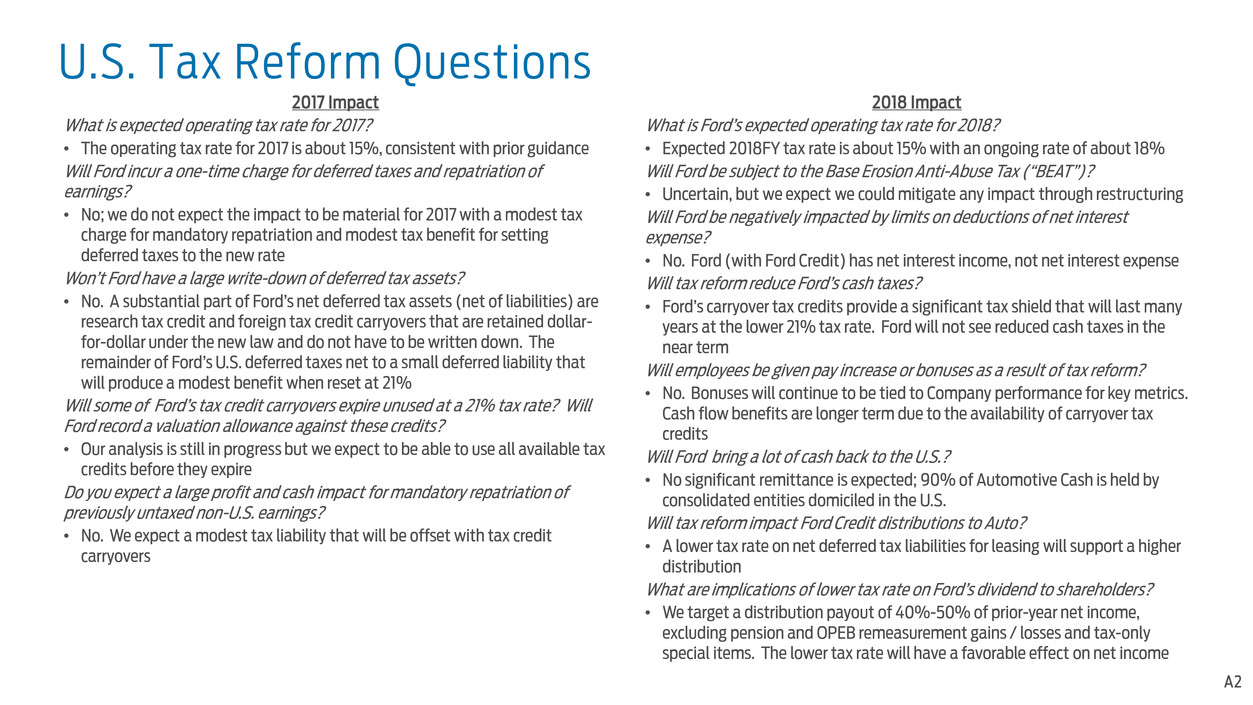
41 2017 Impact What is expected operating tax rate for 2017? • The operating tax rate for 2017 is about 15%, consistent with prior guidance Will Ford incur a one-time charge for deferred taxes and repatriation of earnings? • No; we do not expect the impact to be material for 2017 with a modest tax charge for mandatory repatriation and modest tax benefit for setting deferred taxes to the new rate Won’t Ford have a large write-down of deferred tax assets? • No. A substantial part of Ford’s net deferred tax assets (net of liabilities) are research tax credit and foreign tax credit carryovers that are retained dollar- for-dollar under the new law and do not have to be written down. The remainder of Ford’s U.S. deferred taxes net to a small deferred liability that will produce a modest benefit when reset at 21% Will some of Ford’s tax credit carryovers expire unused at a 21% tax rate? Will Ford record a valuation allowance against these credits? • Our analysis is still in progress but we expect to be able to use all available tax credits before they expire Do you expect a large profit and cash impact for mandatory repatriation of previously untaxed non-U.S. earnings? • No. We expect a modest tax liability that will be offset with tax credit carryovers 2018 Impact What is Ford’s expected operating tax rate for 2018? • Expected 2018FY tax rate is about 15% with an ongoing rate of about 18% Will Ford be subject to the Base Erosion Anti-Abuse Tax (“BEAT”)? • Uncertain, but we expect we could mitigate any impact through restructuring Will Ford be negatively impacted by limits on deductions of net interest expense? • No. Ford (with Ford Credit) has net interest income, not net interest expense Will tax reform reduce Ford’s cash taxes? • Ford’s carryover tax credits provide a significant tax shield that will last many years at the lower 21% tax rate. Ford will not see reduced cash taxes in the near term Will employees be given pay increase or bonuses as a result of tax reform? • No. Bonuses will continue to be tied to Company performance for key metrics. Cash flow benefits are longer term due to the availability of carryover tax credits Will Ford bring a lot of cash back to the U.S.? • No significant remittance is expected; 90% of Automotive Cash is held by consolidated entities domiciled in the U.S. Will tax reform impact Ford Credit distributions to Auto? • A lower tax rate on net deferred tax liabilities for leasing will support a higher distribution What are implications of lower tax rate on Ford’s dividend to shareholders? • We target a distribution payout of 40%-50% of prior-year net income, excluding pension and OPEB remeasurement gains / losses and tax-only special items. The lower tax rate will have a favorable effect on net income U.S. Tax Reform Questions A2

42 Company Net Income Reconciliation To Adjusted Pre-Tax Profit A3 (Bils) Memo: FY Preliminary 2015 2016 Prelim. 2017 4Q 2017 Net income attributable to Ford (GAAP) 7.4$ 4.6$ 7.8$ 2.6$ Income / (Loss) attributable to non-controlling interests - - - - Net income 7.4$ 4.6$ 7.8$ 2.6$ Less: Provision for income taxes (2.9) (2.2) (0.3) 0.7 Income before income taxes 10.3$ 6.8$ 8.1$ 1.9$ Less: Special items pre-tax (0.5) (3.6) (0.3) 0.2 Adjusted pre-tax profit (Non-GAAP) 10.8$ 10.4$ 8.4$ 1.7$

43 Company Earnings Per Share Reconciliation To Adjusted Earnings Per Share A Memo: FY Preliminary 2015 2016 Prelim. 2017 4Q 2017 Diluted After-Tax Results (Bils) Diluted after-tax results (GAAP) 7.4$ 4.6$ 7.8$ 2.6$ Less: Impact of pre-tax and tax special items (0.3) (2.5) 0.7 1.0 Adjusted net income – diluted (Non-GAAP) 7.7$ 7.1$ 7.1$ 1.6$ Basic and Diluted Shares (Bils) Basic shares (average shares outstanding) 4.0 4.0 4.0 4.0 Net dilutive options and unvested restricted stock units - - - - Diluted shares 4.0 4.0 4.0 4.0 Earnings per share – diluted (GAAP) 1.84$ 1.15$ 1.95$ 0.65$ Less: Net impact of adjustments (0.09) (0.61) 0.17 0.26 Adjusted earnings per share – diluted (Non-GAAP) 1.93$ 1.76$ 1.78$ 0.39$
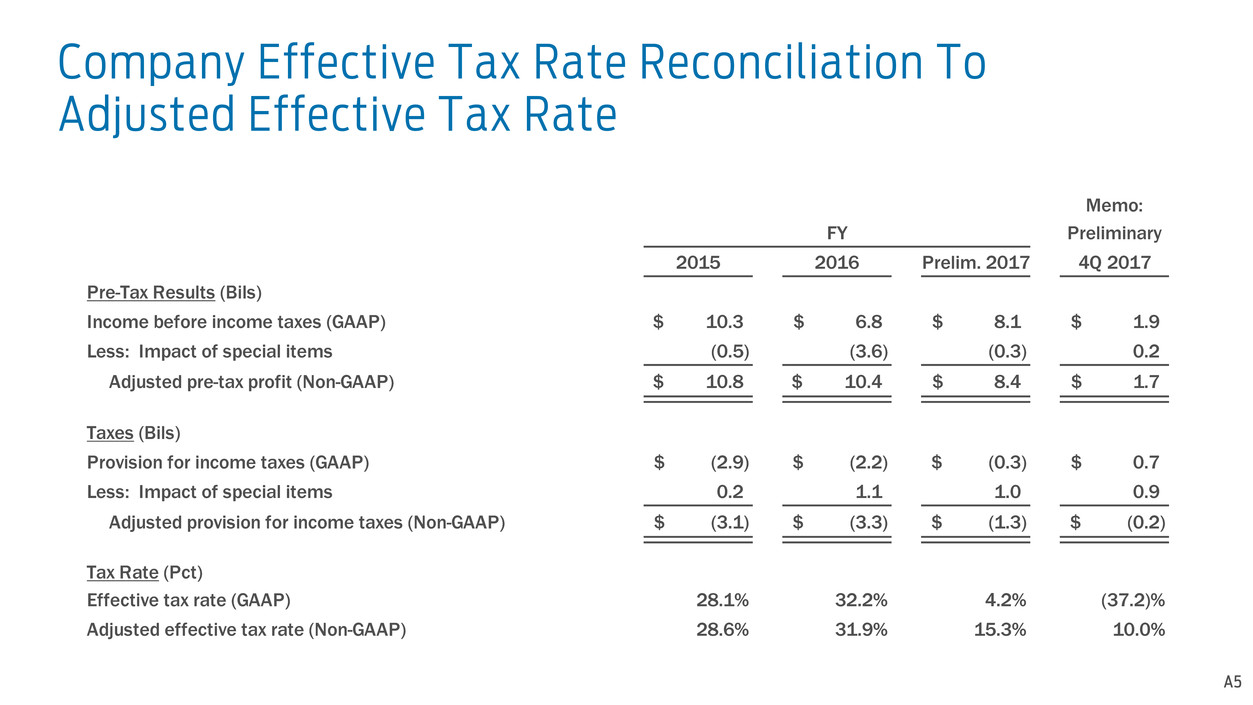
44 Company Effective Tax Rate Reconciliation To Adjusted Effective Tax Rate Memo: FY Preliminary 2015 2016 Prelim. 2017 4Q 2017 Pre-Tax Results (Bils) Income before income taxes (GAAP) 10.3$ 6.8$ 8.1$ 1.9$ Less: Impact of special items (0.5) (3.6) (0.3) 0.2 Adjusted pre-tax profit (Non-GAAP) 10.8$ 10.4$ 8.4$ 1.7$ Taxes (Bils) Provision for income taxes (GAAP) (2.9)$ (2.2)$ (0.3)$ 0.7$ Less: Impact of special items 0.2 1.1 1.0 0.9 Adjusted provision for income taxes (Non-GAAP) (3.1)$ (3.3)$ (1.3)$ (0.2)$ Tax Rate (Pct) Effective tax rate (GAAP) 28.1% 32.2% 4.2% (37.2)% Adjusted effective tax rate (Non-GAAP) 28.6% 31.9% 15.3% 10.0% A5
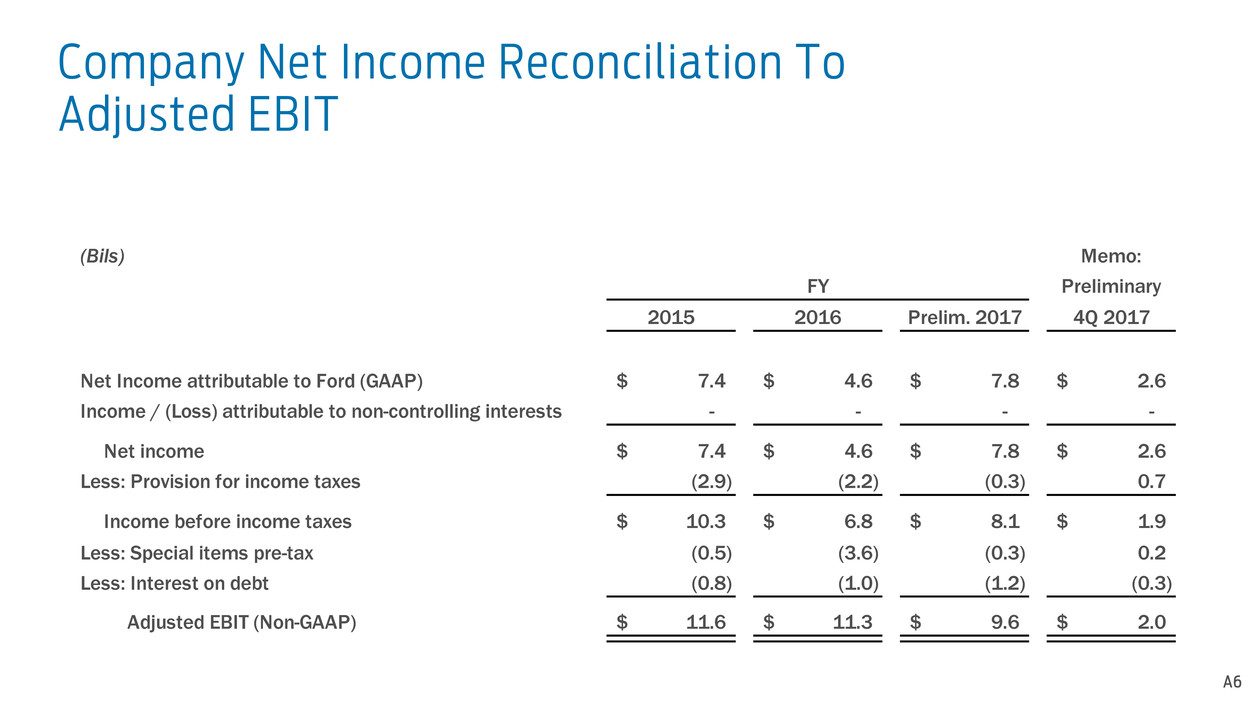
45 Company Net Income Reconciliation To Adjusted EBIT A6 (Bils) Memo: FY Preliminary 2015 2016 Prelim. 2017 4Q 2017 Net Income attributable to Ford (GAAP) 7.4$ 4.6$ 7.8$ 2.6$ Income / (Loss) attributable to non-controlling interests - - - - Net income 7.4$ 4.6$ 7.8$ 2.6$ Less: Provision for income taxes (2.9) (2.2) (0.3) 0.7 Income before income taxes 10.3$ 6.8$ 8.1$ 1.9$ Less: Special items pre-tax (0.5) (3.6) (0.3) 0.2 Less: Interest on debt (0.8) (1.0) (1.2) (0.3) Adjusted EBIT (Non-GAAP) 11.6$ 11.3$ 9.6$ 2.0$
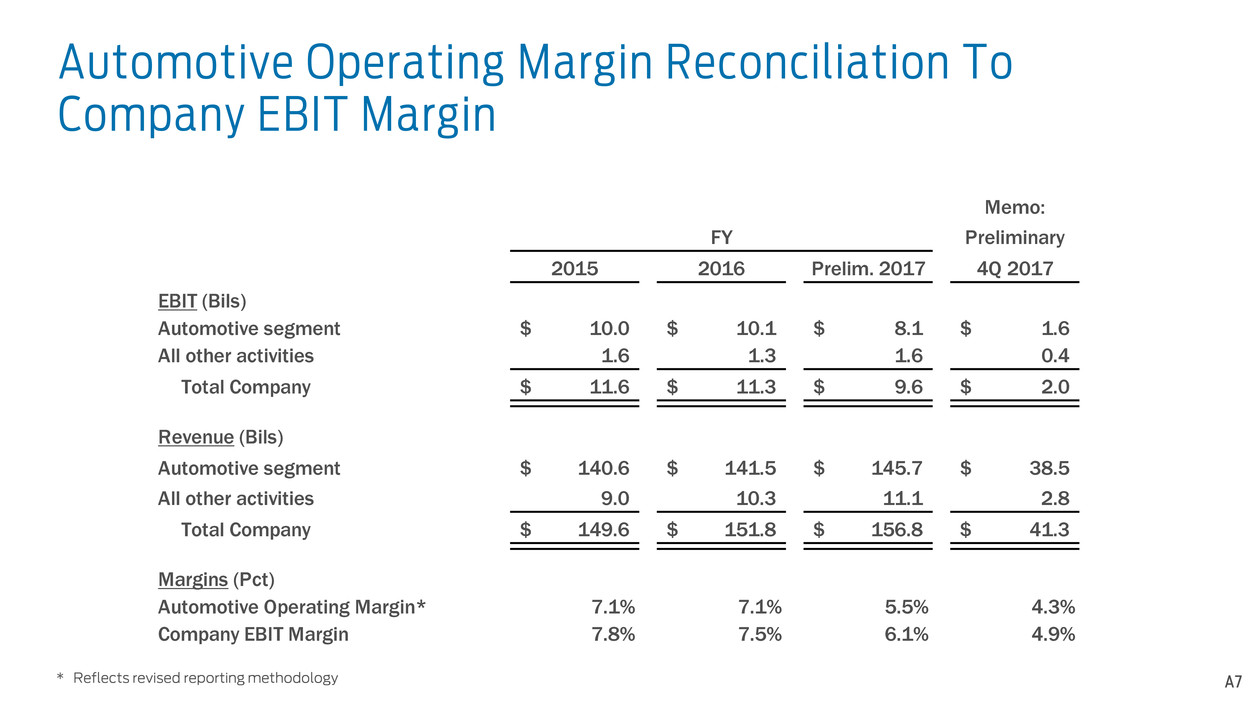
46 Automotive Operating Margin Reconciliation To Company EBIT Margin A7 Memo: FY Preliminary 2015 2016 Prelim. 2017 4Q 2017 EBIT (Bils) Automotive segment 10.0$ 10.1$ 8.1$ 1.6$ All other activities 1.6 1.3 1.6 0.4 Total Company 11.6$ 11.3$ 9.6$ 2.0$ Revenue (Bils) Automotive segment 140.6$ 141.5$ 145.7$ 38.5$ All other activities 9.0 10.3 11.1 2.8 Total Company 149.6$ 151.8$ 156.8$ 41.3$ Margins (Pct) Automotive Operating Margin* 7.1% 7.1% 5.5% 4.3% Company EBIT Margin 7.8% 7.5% 6.1% 4.9% * Reflects revised reporting methodology

47 Preliminary 4Q 2017 Results Company Revenue (GAAP) Company Adjusted Pre-Tax Results* (Non-GAAP) Adjusted EPS* (Non-GAAP) EPS (GAAP) Automotive Segment Operating Margin (GAAP) Automotive Segment Operating Cash Flow (GAAP) 4Q 2017 $41.3B $1.7B $0.39 $0.65 3.7% $2.3B B / (W) 4Q 2016 $2.6B $(0.4)B $0.09 $0.85 (2.0) ppts $0.8B $ * See Appendix for detail, reconciliation to GAAP and definitions A8
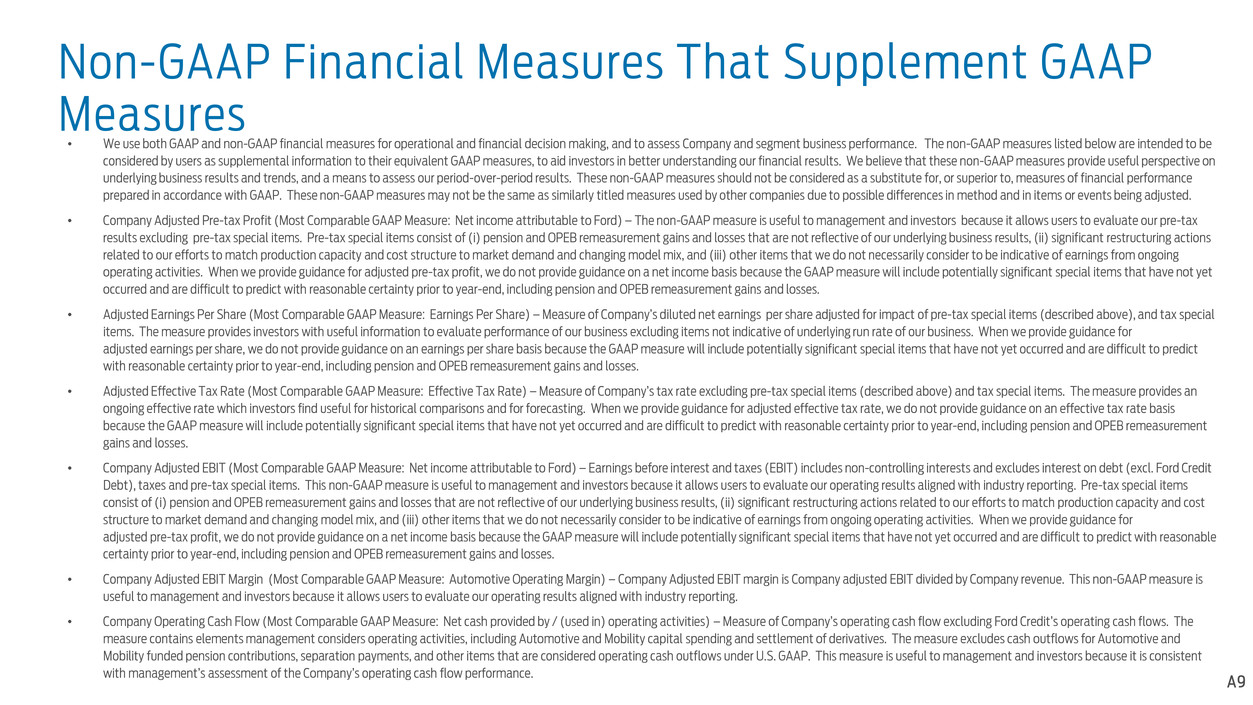
48 Non-GAAP Financial Measures That Supplement GAAP Measures • We use both GAAP and non-GAAP financial measures for operational and financial decision making, and to assess Company and segment business performance. The non-GAAP measures listed below are intended to be considered by users as supplemental information to their equivalent GAAP measures, to aid investors in better understanding our financial results. We believe that these non-GAAP measures provide useful perspective on underlying business results and trends, and a means to assess our period-over-period results. These non-GAAP measures should not be considered as a substitute for, or superior to, measures of financial performance prepared in accordance with GAAP. These non-GAAP measures may not be the same as similarly titled measures used by other companies due to possible differences in method and in items or events being adjusted. • Company Adjusted Pre-tax Profit (Most Comparable GAAP Measure: Net income attributable to Ford) – The non-GAAP measure is useful to management and investors because it allows users to evaluate our pre-tax results excluding pre-tax special items. Pre-tax special items consist of (i) pension and OPEB remeasurement gains and losses that are not reflective of our underlying business results, (ii) significant restructuring actions related to our efforts to match production capacity and cost structure to market demand and changing model mix, and (iii) other items that we do not necessarily consider to be indicative of earnings from ongoing operating activities. When we provide guidance for adjusted pre-tax profit, we do not provide guidance on a net income basis because the GAAP measure will include potentially significant special items that have not yet occurred and are difficult to predict with reasonable certainty prior to year-end, including pension and OPEB remeasurement gains and losses. • Adjusted Earnings Per Share (Most Comparable GAAP Measure: Earnings Per Share) – Measure of Company’s diluted net earnings per share adjusted for impact of pre-tax special items (described above), and tax special items. The measure provides investors with useful information to evaluate performance of our business excluding items not indicative of underlying run rate of our business. When we provide guidance for adjusted earnings per share, we do not provide guidance on an earnings per share basis because the GAAP measure will include potentially significant special items that have not yet occurred and are difficult to predict with reasonable certainty prior to year-end, including pension and OPEB remeasurement gains and losses. • Adjusted Effective Tax Rate (Most Comparable GAAP Measure: Effective Tax Rate) – Measure of Company’s tax rate excluding pre-tax special items (described above) and tax special items. The measure provides an ongoing effective rate which investors find useful for historical comparisons and for forecasting. When we provide guidance for adjusted effective tax rate, we do not provide guidance on an effective tax rate basis because the GAAP measure will include potentially significant special items that have not yet occurred and are difficult to predict with reasonable certainty prior to year-end, including pension and OPEB remeasurement gains and losses. • Company Adjusted EBIT (Most Comparable GAAP Measure: Net income attributable to Ford) – Earnings before interest and taxes (EBIT) includes non-controlling interests and excludes interest on debt (excl. Ford Credit Debt), taxes and pre-tax special items. This non-GAAP measure is useful to management and investors because it allows users to evaluate our operating results aligned with industry reporting. Pre-tax special items consist of (i) pension and OPEB remeasurement gains and losses that are not reflective of our underlying business results, (ii) significant restructuring actions related to our efforts to match production capacity and cost structure to market demand and changing model mix, and (iii) other items that we do not necessarily consider to be indicative of earnings from ongoing operating activities. When we provide guidance for adjusted pre-tax profit, we do not provide guidance on a net income basis because the GAAP measure will include potentially significant special items that have not yet occurred and are difficult to predict with reasonable certainty prior to year-end, including pension and OPEB remeasurement gains and losses. • Company Adjusted EBIT Margin (Most Comparable GAAP Measure: Automotive Operating Margin) – Company Adjusted EBIT margin is Company adjusted EBIT divided by Company revenue. This non-GAAP measure is useful to management and investors because it allows users to evaluate our operating results aligned with industry reporting. • Company Operating Cash Flow (Most Comparable GAAP Measure: Net cash provided by / (used in) operating activities) – Measure of Company’s operating cash flow excluding Ford Credit’s operating cash flows. The measure contains elements management considers operating activities, including Automotive and Mobility capital spending and settlement of derivatives. The measure excludes cash outflows for Automotive and Mobility funded pension contributions, separation payments, and other items that are considered operating cash outflows under U.S. GAAP. This measure is useful to management and investors because it is consistent with management’s assessment of the Company’s operating cash flow performance. A9















































